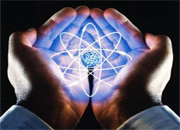The agreement is rarely talked about today, but it has been a huge success: Nearly 10% of all electricity in the U.S. is generated by nuclear material taken from the tips of Russian missiles once aimed at American cities.
Think about that: one in every ten lightbulbs in U.S. kitchens, Wal-Marts and baseball stadiums is illuminated by nuclear energy initially designed to obliterate millions of Americans. On Thursday, the U.S. National Nuclear Security Administration (NNSA), which monitors the dismantling of Russian weapons on behalf of the U.S. government, announced that the agreement has reached a milestone: Approximately 400 metric tons of Russian highly enriched uranium — the equivalent of around 16,000 nuclear weapons — have now been converted into low-enriched uranium, the form of the element needed to power nuclear reactors. In the vexing effort to rid the world of nuclear weapons, this little-publicized agreement provides arms-control advocates with an inspirational example of success — and a model for how to move forward. (See "Medvedev and Obama: Sunshine in Moscow.")
"This is one of the most innovative and successful programs devised, and the concept was so simple," says William Potter, Director of the James Martin Center for Nonproliferation Studies at the Monterey Institute of International Studies. "When Americans turn on their lights at night they are demonstrating the power of nuclear-arms control. I don't think many people appreciate that."
The HEU Purchase Agreement is casually known among arms-control experts as the Megatons to Megawatts program, because nuclear bombs carry the force of millions of tons of dynamite, while power plants can generate millions of watts of electricity. It also falls under a principle elucidated by President Dwight Eisenhower, who, paraphrasing the Bible, suggested that because the binding energy of uranium can be released all at once by bombs (so as to level cities) or over time by powers plants (so as to provide them with electricity), nuclear swords can be beaten into nuclear plowshares.
The deal has been a win-win for both sides. By the time it is complete in 2013, Russia will have earned around $8 billion from American energy company USEC Inc., in return for uranium fuel that USEC has sold on to U.S. reactors for a profit. USEC says that, all told, it will have received the equivalent of 3 billion tons of coal or 10 billion barrels of oil — enough to power the entire U.S. for two years. (See a brief history of arms control deals.)
Yet it is unlikely that Russia will agree to continue the Purchase Agreement past its expiration in three years' time. It feels that the price it receives from USEC for the uranium is too low, say U.S. officials close to the negotiations. But Russia has expressed interest in dismantling further weapons and selling the uranium on the open market. And U.S. government officials say they are open to amending the agreement accordingly — especially if Russia continues to allow NNSA inspectors to monitor the dismantling of the weapons to ensure the uranium Russia sells does indeed come from warheads.
"We've made no secret that we are interested in pursuing this arrangement beyond 2013," says Mark Whitney, an assistant deputy administrator at the NNSA. "The Russians have said they would prefer the arrangement to be on commercials terms. That's not something that would be excluded by our government."
How many weapons Russia is willing to dismantle, of course, depends on how many it considers to be in excess of its military needs. That figure, in turn, depends on the success of arms-control initiatives such as the recently signed START follow-on treaty, which limits the number of nuclear weapons deployed by both sides and which is currently awaiting ratification by Russian and U.S. legislatures. Plus, the program only works for uranium weapons, as weapons-grade plutonium (the other fissile material used in bombs) can't be as cheaply downblended into reactor fuel. But the central idea — that there is a financial incentive to disarmament — can be a powerful tool to reinvigorate the wider nonproliferation movement. (See "Is Obama Overselling His Russia Arms Control Deal?")
Matthew Bunn of Harvard University's Belfer Center for Science and International Affairs has suggested that both the U.S. and Russia should offer to sell reactors to countries that wish to develop nuclear-power plants, with a unique sweetener — five years of free low-enriched uranium that's guaranteed to have come from dismantled warheads. Such a plan would provide a public relations boost for the buyer country, help the U.S. and Russia honor their commitment under the Nuclear NonProliferation Treaty to "take effective measures relating to... nuclear disarmament," and bring business to U.S. and Russian companies that sell nuclear technology. It would also avoid a situation in which countries demand the right to enrich their own uranium, which inevitably raises suspicion of illicit weapons programs, as is currently the case with Iran. (Comment on this story.)
And if converting megatons to megawatts can work for the U.S and Russia, there's no reason it can't work elsewhere. Both India and Pakistan wish to increase their nuclear power-generating capacity in the coming years. Imagine what a powerful (and potentially profitable) gesture it would be if Indian power plants used fuel taken from Pakistani weapons.
"Time"
10 Декабря 2025 | среда | 18:55


